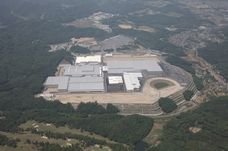Honda to Open First New Japan Plant in 49 Years

In 1964, just as the country was preparing to host the Olympic Games, Honda inaugurated a plant in Sayama, near Tokyo.
That factory, along with two older ones, met surging Japanese domestic demand as the country prospered.
And since the early 1990s, when asset prices collapsed, ushering in Japan's "lost decade," there has been little need for expansion.
The new factory, with an annual capacity of 250,000 vehicles, is opening just as a weaker yen is making Japanese manufacturers such as Honda more profitable. Plans for the new plant were unveiled in July 2010 as part of Honda's efforts to build smaller, more fuel-efficient vehicles.
In recent months, investors have flocked back to Japan, pushing the benchmark Nikkei 225 Stock Average to levels unseen since 2008. Evidence of a broader recovery is growing as economists predict the economy will emerge from recession this quarter.
The factory, in Yorii, a downtrodden city of about 36,000 two hours northwest of Tokyo, illustrates how that optimism is spreading from Tokyo's trading floors to smaller towns.
"Honda is a world-renowned company and it's coming -- who wouldn't be excited?" said Tomiko Yokota, who runs a Yorii restaurant serving fried pork cutlets that's been in her family for more than a century. "There will be more people, more traffic. We're too small to fit lots of people, but we do take- out bentos too."
West Virginia
Honda says the new factory is part of a reorganization of its domestic operations that includes scaling back Sayama.
Yorii will use more efficient technology and allow the company to consolidate production of compact models such as the Fit, its top seller in Japan.
The factory is a departure from recent decades. Honda, Toyota Motor Corp. and Nissan Motor Co. have opened dozens of overseas plants from West Virginia to China's Tianjin as Japanese car demand stagnated along with the economy.
Honda factories outside Japan account for about three-quarters of the company's annual output of 4 million cars. The Yorii plant "is very important because big companies have high multiplier effects and will lead to many jobs," said Jesper Koll, head of Japanese equity research at JPMorgan Chase & Co. in Tokyo.
It shows Japan's recovery is "not just about the exchange rate, but that what is happening is concrete and signals Japan is now a viable host for cutting-edge manufacturing."
Yellowing billboards
Like most of Japan, Yorii has seen its share of economic malaise. During lunchtime on a recent weekday, the local sushi restaurant is only one-third full, and on the main shopping street numerous stores are shuttered. At the exit of Yorii train station, yellowing signs hang on billboards, seeking advertisers.
"All the bars I used to go to have closed, and when new shops open, they shut quickly," said Shozaburo Aoyanagi, a 63-year-old taxi driver who has lived in Yorii for two decades.
"That Seven-Eleven is new," he said, pointing to a nearby store. "It won't last. There's no one here."
Yorii officials expect that to change. The local government says 3,800 jobs will be created by fiscal 2017 thanks to Honda and its suppliers. "They're going to need to live somewhere, eat somewhere, and throw year-end parties," said Yoshiro Harada, a 71-year-old owner of a sushi restaurant in Yorii.
Cheaper yen
Honda is opening the plant as the yen is falling against major currencies. It has dropped more than 12 percent against the dollar since polls in mid-November signaled Shinzo Abe would become prime minister.
The cheaper currency boosts the value of Japanese products sold overseas and has prompted companies such as Toyota and Fast Retailing Co. to raise earnings forecasts in the past month.
Honda on Jan. 31 trimmed its profit outlook for the fiscal year ending March, though those projections were based on a stronger yen.
The yen this week traded as low as 94.77, the weakest level since 2009.
Analysts surveyed by Bloomberg expect Honda to post a profit of 406 billion yen ($4.4 billion) for the current fiscal year, or almost double the previous year's level. Honda shares have jumped about 40 percent since the end of October, versus gains of more than 50 percent for Toyota and more than 30 percent for Nissan.
Given that the Yorii plant has been in the works for six years, "the timing is very lucky for Honda," said Martin Schulz, senior economist at Fujitsu Research Institute in Tokyo.
Nonetheless, he cautions that competition from other Asian countries has grown so much that it will be hard for Japanese manufacturers to ever regain the primacy they once enjoyed.
'Younger people'
Last December, the number of manufacturing jobs in Japan fell below 10 million for the first time since 1961. According to the Japan Center for Economic Research, Japanese manufacturing jobs may fall to 8.3 million in 2015 from a peak of 16 million in 1992.
The Japan Automobile Manufacturers Association expects domestic sales to fall 12 percent this year.
The broader economy is of little interest to Kazuyo Imamura, who has run a ramen shop in Yorii for 30 years.
What interests the 60-year-old is the new factory's effect on the town.
"I don't know about jobs and all that, but I hope more younger people come in," Imamura said. "You don't see many young people around in Yorii right now."
Related News


